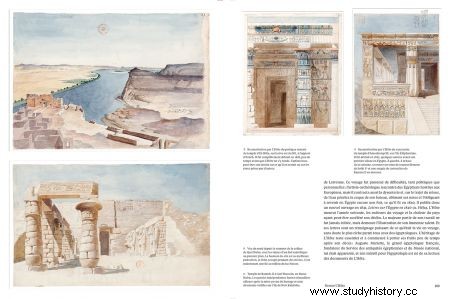"Egyptologists' Notebooks", by author Chris Naunton, captures the fascination of the early adventurers and scholars of Egyptology's golden age, through the publication of their field diaries and sketches.

Drawing by Denon of the portico of the temple of Thoth, at Hermopolis.
"These were the tombs of the ancient Egyptians (…), their entrances look like narrow mouths of wells (…) about 18 meters deep". Apart from a few details, these remarks could have been made in 2020 during the sensational announcement of the discovery of hundreds of sarcophagi at the bottom of funeral shafts on the Saqqara plateau, near Cairo. However, these descriptions date from the 19th century and are taken from "Carnets d'Egyptologues". In other words, field diaries of the very first explorers and archaeologists to have marveled at the majesty of the ancient ruins encountered along the Nile and selected here by the British Egyptologist Chris Naunton who had the good idea to bring together in a published book by EPA-Editions. Enough to maintain the fascination exercised for centuries by the treasures found in ancient Egypt by admiring these sketches and colored sketches of the first scholars to have gone to the land of the Pharaohs to study the monumental vestiges little by little devoured by the desert sands.
 Reconstructions by Nestor L'Hôte (1804-1842) of the temple of El-Hilla, on the east bank of the Nile; the hill of Qasr Ibrim and its Meroitic ruins; the temple of Ramses II, at Gerf Hussein, in Lower Nubia; and the Temple Sanctuary of Amenhotep III, on Elephantine Island. Credits:BNF
Reconstructions by Nestor L'Hôte (1804-1842) of the temple of El-Hilla, on the east bank of the Nile; the hill of Qasr Ibrim and its Meroitic ruins; the temple of Ramses II, at Gerf Hussein, in Lower Nubia; and the Temple Sanctuary of Amenhotep III, on Elephantine Island. Credits:BNF
Beyond the descriptions and the conditions in which these ancient sites were discovered, these "notebooks" bear witness to the personalities of those who, through their stories, ignited the imaginations of entire generations with their marvelous descriptions of one of the most extraordinary civilizations that carried the planet.
200 years before Champollion, attempts to decipher hieroglyphs by Athanasius Kircher
We thus discover that the German scholar, priest and antiquary Athanasius Kircher (1602-1680) - who had never been to Egypt himself - had nevertheless tried, two hundred years before Champollion, to decipher the hieroglyphs . To do this, he had studied Coptic, Ethiopian and Arabic manuscripts because this scholar had understood before the others that Coptic, the language of the Christian Church of Egypt, had a direct relationship with the ancient language of the pharaohs. Kircher's works are followed by the notebooks and maps of the British traveler Georges Sandys (1578-1644) and his evocations of the first ascents of the galleries of the Great Pyramid of Cheops, with strikingly precise plans given the time. "In the pages of his diary, it almost feels like this is the very first time the West has landed in Egypt “, writes Chris Naunton. The same goes for the stories of the Danish navy captain Frédéric Louis Norden (1708-1742) and his detailed illustrations of the colossi of Memnon or the Sphinx. Those also of the Briton Richard Pococke (1704-1765).
 Drawings by Brocklehurst of the Colossi of Memnon (twin statues of Amenhotep III), at Luxor, and of a scarab representing this pharaoh and his wife Tiyi. Credits:Macclesfield Museums / The Silk Heritage Trust
Drawings by Brocklehurst of the Colossi of Memnon (twin statues of Amenhotep III), at Luxor, and of a scarab representing this pharaoh and his wife Tiyi. Credits:Macclesfield Museums / The Silk Heritage Trust
Napoleon and the "Description of Egypt"
A chapter is dedicated - how could it be otherwise? – the Egyptian campaign led by Napoleon and the competition between England and France, at the end of the 18th century, to seize the land of the Pharaohs. A rivalry both military and scholarly, the race to decipher hieroglyphics having been won by the Frenchman Jean-François Champollion (1790-1832). The French military expedition in 1798, and the work of scientists who accompanied it, such as Dominique Vivant-Denon (1745-1825(, contributed to the editorial success of the colossal "Description of Egypt".
 Jean-François Champollion (1790-1832) devoted his life to the study of ancient languages and had, more than anyone else, a leading role in the decipherment of hieroglyphic writing. On the right, a page from Champollion's manuscript for the "Egyptian Grammar". Credits:Champollion Museum - Figeac/BNF
Jean-François Champollion (1790-1832) devoted his life to the study of ancient languages and had, more than anyone else, a leading role in the decipherment of hieroglyphic writing. On the right, a page from Champollion's manuscript for the "Egyptian Grammar". Credits:Champollion Museum - Figeac/BNF
This was followed by a number of period biographies and illustrations by Frédéric Caillaud, James Burton, Edward William Lane, Nestor L’Hôte, and the architect Hector Horeau. The last part of the work returns to the very beginnings of Egyptology itself, as a discipline, with the evocation of the Italian explorer and engineer Giovanni Battista Belzoni (1778-1823), French archaeologists Jean- Jacques Rifaud (1786-1852) and Victor Loret (1859-1946) to whom we owe the discovery of so many tombs in the Valley of the Kings; or even that of the British Matthew Flinders Petrie (1853-1942), Amélia Edwards, Marianne Blockehurst, up to the most famous of all, Howard Carter, the discoverer of the tomb of tombs, that of Tutankhamen and his prodigious riches. An exciting book, wonderfully illustrated, which revives the pioneering spirit of the discoverers of the treasures of the Nile.
"Egyptologist Notebooks", Chris Naunton, editions E/P/A, 2020, 256p., 35 Euros
